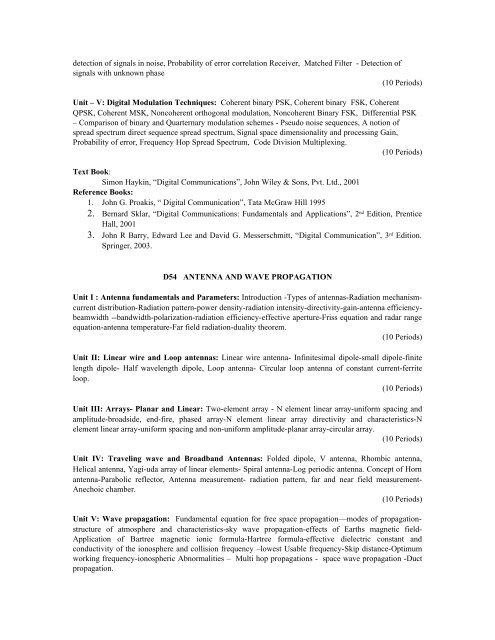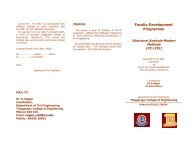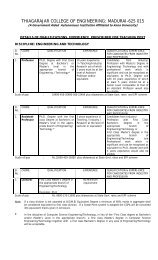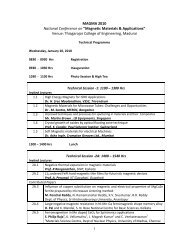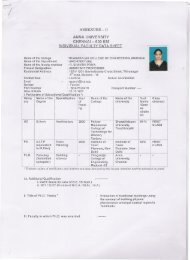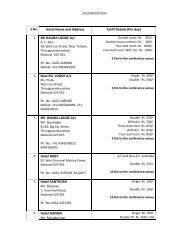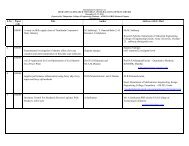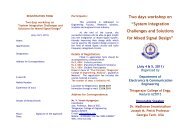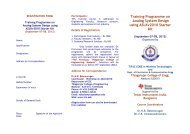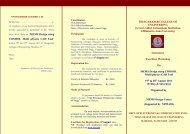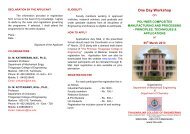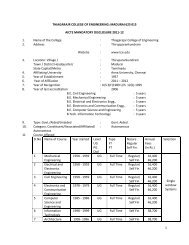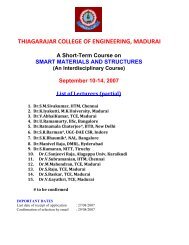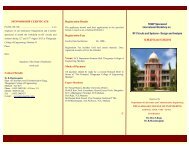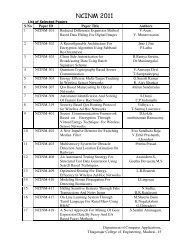THIAGARAJAR COLLEGE OF ENGINEERING: MADURAI – 625 015 ...
THIAGARAJAR COLLEGE OF ENGINEERING: MADURAI – 625 015 ...
THIAGARAJAR COLLEGE OF ENGINEERING: MADURAI – 625 015 ...
- TAGS
- thiagarajar
- college
- madurai
- tce.edu
Create successful ePaper yourself
Turn your PDF publications into a flip-book with our unique Google optimized e-Paper software.
detection of signals in noise, Probability of error correlation Receiver, Matched Filter - Detection of<br />
signals with unknown phase<br />
(10 Periods)<br />
Unit <strong>–</strong> V: Digital Modulation Techniques: Coherent binary PSK, Coherent binary FSK, Coherent<br />
QPSK, Coherent MSK, Noncoherent orthogonal modulation, Noncoherent Binary FSK, Differential PSK<br />
<strong>–</strong> Comparison of binary and Quarternary modulation schemes - Pseudo noise sequences, A notion of<br />
spread spectrum direct sequence spread spectrum, Signal space dimensionality and processing Gain,<br />
Probability of error, Frequency Hop Spread Spectrum, Code Division Multiplexing.<br />
(10 Periods)<br />
Text Book:<br />
Simon Haykin, “Digital Communications”, John Wiley & Sons, Pvt. Ltd., 2001<br />
Reference Books:<br />
1. John G. Proakis, “ Digital Communication”, Tata McGraw Hill 1995<br />
2. Bernard Sklar, “Digital Communications: Fundamentals and Applications”, 2 nd Edition, Prentice<br />
Hall, 2001<br />
3. John R Barry, Edward Lee and David G. Messerschmitt, “Digital Communication”, 3 rd Edition.<br />
Springer, 2003.<br />
D54 ANTENNA AND WAVE PROPAGATION<br />
Unit I : Antenna fundamentals and Parameters: Introduction -Types of antennas-Radiation mechanismcurrent<br />
distribution-Radiation pattern-power density-radiation intensity-directivity-gain-antenna efficiencybeamwidth<br />
--bandwidth-polarization-radiation efficiency-effective aperture-Friss equation and radar range<br />
equation-antenna temperature-Far field radiation-duality theorem.<br />
(10 Periods)<br />
Unit II: Linear wire and Loop antennas: Linear wire antenna- Infinitesimal dipole-small dipole-finite<br />
length dipole- Half wavelength dipole, Loop antenna- Circular loop antenna of constant current-ferrite<br />
loop.<br />
(10 Periods)<br />
Unit III: Arrays- Planar and Linear: Two-element array - N element linear array-uniform spacing and<br />
amplitude-broadside, end-fire, phased array-N element linear array directivity and characteristics-N<br />
element linear array-uniform spacing and non-uniform amplitude-planar array-circular array.<br />
(10 Periods)<br />
Unit IV: Traveling wave and Broadband Antennas: Folded dipole, V antenna, Rhombic antenna,<br />
Helical antenna, Yagi-uda array of linear elements- Spiral antenna-Log periodic antenna. Concept of Horn<br />
antenna-Parabolic reflector, Antenna measurement- radiation pattern, far and near field measurement-<br />
Anechoic chamber.<br />
(10 Periods)<br />
Unit V: Wave propagation: Fundamental equation for free space propagation—modes of propagationstructure<br />
of atmosphere and characteristics-sky wave propagation-effects of Earths magnetic field-<br />
Application of Bartree magnetic ionic formula-Hartree formula-effective dielectric constant and<br />
conductivity of the ionosphere and collision frequency <strong>–</strong>lowest Usable frequency-Skip distance-Optimum<br />
working frequency-ionospheric Abnormalities <strong>–</strong> Multi hop propagations - space wave propagation -Duct<br />
propagation.


